by Niki Crawson | May 31, 2019
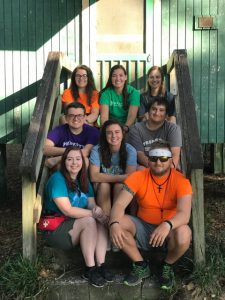
Pictured:
Top L-R: Jessie, Katelyn, Olivia
Middle L-R: Mason, Clair, Matt
Bottom L-R: Hailee, Miles
For campers, getting to know their camp staff is beyond just learning names and faces. It is an important aspect of belonging, one of 4-H’s essential elements included in every facet of our program. So, when camp time rolls around each year, Ms. Ariel, our fabulous Resident Camp Director at 4-H Camp Timpoochee, responds to our call for a little early information on the latest and greatest members to join the team, the 4-H Camp Timpoochee Camp Staff. Without further delay, allow us to introduce our trained camp team for Summer 2019:
Meet Mason, a 2nd year camp staff member and student majoring in Recreation, Tourism and Events, from Cottondale, FL. His favorite camp activity is Marshmallow Paint War, favorite camp song is “5 Little Muffins,” and favorite canteen items are water and Twix bars. Something interesting about Mason that we just learned is that he once spent 13 days in South Africa. He shared that, because of camp, he understands that a small act of kindness can go a long way.
Jessie’s hometown is Chipley, FL and is also a 2nd year camp staff member. She is majoring in Natural Science. Her camp heart song is “Down by the Bay,” her favorite camp activity is sitting outside during free recreation and hanging out with the campers. Her favorite canteen snack at camp is Reese’s Peanut Butter Cups and a little fact about Jessie is that she can eat twelve chocolate chip cookies at one time! She shared that because of camp, she is allowed to meet new people and create memories and adventures not only for herself but for others as well.
Hailee hails from Stuart, FL and she joins the camp staff for the first time this year. She is a Marine Biology student so her favorite song is “Just Keep Swimming” of course! Her favorite camp activity is Smores and her canteen snack of choice is a Snickers bar. An interesting fact about Hailee is that she collects snow globes and pressed pennies from all over the world. Because of camp, Hailee says she can help create memories that her campers, fellow staff, and she will never forget.
Katelyn, originally grew up in Middleton, NH but now calls DeFuniak Springs, FL home. She is also a 1st year camp staff member and is studying Microbiology. Her favorite camp song is “You’re Momma Don’t Wear No Socks” and she loves to kayak and then snack on Skittles and Sprite during canteen. She shared that she once lived in Alaska for a period of time. Katelyn said that, because of camp, she gets to work with awesome youth and staff for the summer.
Matthew joins us from Pensacola, FL as a 2nd year camp staff member studying Mass Communication with a focus on advertising and a minor in psychology. His favorite camp song is “Bomdalele,” his favorite camp activity is movie night, and his canteen snack of choice is a Kit Kat with a Dr. Pepper. An interesting fact about Matthew is that he has 10 siblings and 49 first cousins! Because of camp, Matthew says he gets to make other people as happy as he possibly can.
Miles, a Chemistry major, is also from the west coast, Santa Rosa, CA, and this is his 2nd year as a camp staff. His favorite camp song is “Down to the Swamp,” and he enjoys a Pepsi and a Crunch bar after his favorite camp activity, going out on the boat. Something interesting about Miles is that he rides a motorcycle. He shares that because of camp, he is responsible.
Clair is a Marine Science major and 1st year camp staff from Archer, FL. Her favorite camp song is “The Princess Pat,” her favorite camp activity is campfire time, and she loves to eat Kit Kats during canteen. Something unique about Clair is that she built herself a wooden kayak once. Because of camp, she shares that she gets to teach others about her passion, the ocean.
Olivia is from Grand Ridge, FL, also a 1st year staff member, and is majoring in Business. Her favorite song is, “I’m a Little Coconut,” her favorite activity is Marshmallow Paint War, and she snags Cheese-Its during canteen. In her spare time, she loves to travel. Olivia shares that, because of camp, she gets to meet many new people and play a small role in the campers’ lives, helping them have an amazing week at summer camp.
Thank you again to Ms. Ariel and her camp team for taking the time to share with us before we kick off the 4-H Camp Timpoochee summer residential camping season. If you’d like to learn more about 4-H Camp and how you can send your child to 4-H camp for a week of fun-filled camp traditions, life-long memories, and long-term friendships, please contact your local UF IFAS County Extension Office, or visit http://florida4h.org.

by bestevez | May 29, 2019
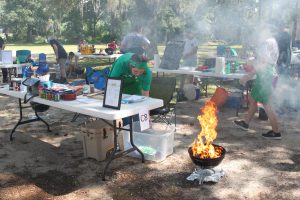
A 2018 NW District 4-H Tailgating Contest participant prepares to grill
Imagine the smell of a charcoal grill on a breezy summer day. A neighbor is grilling in their backyard, and you wish you were invited over for dinner. Would it be even better if it was your child or grandchild doing the grilling for you?
Fire up Your Grill!
4-H members have been firing up their charcoal grills and participating in the Florida 4-H Tailgating Contest since 2016. Designed to promote the use of animal protein in the diet, youth learn the art and science of safely preparing beef, pork, poultry, and seafood in an outdoor setting providing opportunities for 4-H youth to develop life skills, including decision making and healthy lifestyle choices.
In the Florida 4-H Tailgating Contest, youth grill two, 6-8 ounce portions of one of the following proteins:
- beef
- pork
- poultry – turkey breast or half chicken
- shrimp – fresh, headless and de-veined
While youth are grilling, judges observe food and fire safety actions and ask questions about the recipe and safety knowledge. A team of judges evaluates the cooked product by taste testing and scoring each entry.
4-H Tailgating District Contest
After youth compete at county contests or participate in day camps, they can register for the district contest. There are four district contests hosted throughout the state including our Northwest District contest held at the Washington County Ag Center on July 20, 2019. Cash prizes at the district level are awarded in each protein category – 1st place $400, 2nd place $250, 3rd place $100 and 4th place $50.

Scholarships and prizes are awarded thanks to these sponsors.
4-H Tailgating State Contest
The top two winners from each protein are then eligible to compete in the state contest held at the University of Florida on September 28, 2019. For the state contest, the 1st place winner in each protein area receives a $1,500 college scholarship and the 2nd place winner receives a $1,000 college scholarship.
Since the Florida 4-H Tailgating contest began in 2016, over $63,000 in scholarship money has been awarded to Florida 4-H members made possible by sponsorships from Winn-Dixie, National Beef, and Sonny’s.
Learn More at a Tailgating Day Camp
Last summer, over 100 youth attended day camps to learn about identifying cuts of meat, preventing food cross contamination and food-borne illnesses, grilling techniques, food safety and fire safety. Contact your local UF/IFAS Extension office to find a grilling day camp near you so you can participate in the 2019 Northwest District 4-H Tailgating Contest! Follow us on Facebook to see event details!
Resources
by Prudence Caskey | May 22, 2019
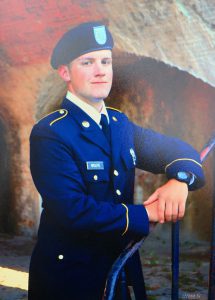
Santa Rosa 4-H member, Private 1st Class Wolf, serves his country in the United States Army.
Receiving an official title can be very exciting for a new employee. Santa Rosa County 4-H member, Payton Wolfe has a new title and he hasn’t even graduated from high school yet. His new title is now Private 1st Class Wolfe. You see, Payton is serving the United States of America in the Army. Wolfe completed his Basic Combat Training during the summer between his Junior and Senior years of high school. He has officially been in the Army for quite some time now.
Payton Wolfe has a love of animal husbandry and has hatched over 5,000 eggs throughout his high school career. During his many years in 4-H, he has raised numerous types of poultry including quail, chickens, pheasants, turkeys and ducks. “I even had a couple of cows, but they were really just for pets, I never showed them,” Payton explained.
Along with animals, Payton has learned to have a heart of service for a long time. He has completed over 300 hours of community service while in Santa Rosa County 4-H. He has served his club as an officer, his community in service projects whenever needed, and now Payton will serve his country in the United States Army for six years. Enrolling in the Army Veterinarian Specialist program seemed like a natural fit for him. He will be helping care for bomb dogs and horses. Thank you for your dedication and service to our country Private First Class Wolfe!
We are proud that Payton is using the skills he learned as a member of 4-H to protect our country and are excited to see how he will continue to serve his world in the years to come. To find out more information about 4-H programs that can offer essential life skills such as leadership, independence, and goal setting to your children so that they will grow up to become successful members of society and have a heart of service like Payton, please contact your local UF/ IFAS County Extension Office, or follow us on Facebook.
by Whitney Cherry | Mar 8, 2019
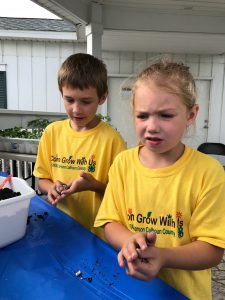
Wildflower seed bombs are a great indoor or outdoor project with unlimited potential for learning.
Wildflower seed bombs are the perfect project for kids itching to get outside. Even if you don’t have a green thumb or you don’t have outdoor space or the weather isn’t cooperating, you can make seed bombs that will help beautify roadsides, vacant areas and neighborhoods.
Give Them a Toss!
These little beauties don’t get their name from any explosive properties but from the fun you have “launching” them around your yard or neighborhood. As you toss them into places that aren’t frequently mowed, you beautify your neighborhood and provide an invaluable food sources for native Florida pollinators like bees, wasps, butterflies, and more.
Even though you may be more fond of some pollinators than others, there’s no doubt we need them all. Their pollination services are critical to fruit development in many of our fruiting crops. So if you like squash, cucumbers, melons, almonds and so much more, here’s what you can do to help:
Gather Your Materials
- Air-dry clay
- Wildflower seeds
- Potting Soil
Make Your Seed Bombs
- Pinch off a small amount of air-dry clay – enough to make a ball about the size of a bouncy ball or about 1″ diameter.
- Work equal parts seeds and soil into the clay and form it into a ball.
Amounts really are up to you. More seeds = more flowers.
But, too much soil will keep the ball from holding it’s shape. If this happens, add more clay and either have a bigger bomb, or divide it into two smaller bombs.
- Store them in a cool dry place and let them dry out completely in an air-tight container until you’re ready to spread some wildflower cheer.
- Now for the fun part! Toss them where you want flowers to grow.
Things to Consider…
- The air-dry clay acts as a binder only. It’s natural, non-toxic, and when wet, it will soften and allow the seeds to grow.
- Before storing in an airtight container, allow your seed bombs out to dry completely. Even a little moisture will allow the seeds to sprout.
- Be careful when throwing your seed bombs.
- Don’t hit people, animals, or other anything else with them – just the ground.
- Throw them where areas don’t get mowed very much. Some people throw them out along roadways or in abandoned lots. If these places are mowed regularly, they won’t last long if they even get to bloom.
- Get permission if you’re throwing them in public places.
Resources
Gardening is just one of the many Florida 4-H programs. To see what programs are available in your county, contact your local UF/IFAS Extension office, or contact your 4-H Agent about starting a gardening program in your county.
by Julie Pigott Dillard | Mar 1, 2019
 Registration opens today for the 2019 4-H Chick Chain project! This project teaches youth how to raise baby chicks to laying age using science-based best practices. At the end of the project, youth compete in a showmanship and skill-a-thon contest to test their knowledge and also exhibit their birds for judging and awards.
Registration opens today for the 2019 4-H Chick Chain project! This project teaches youth how to raise baby chicks to laying age using science-based best practices. At the end of the project, youth compete in a showmanship and skill-a-thon contest to test their knowledge and also exhibit their birds for judging and awards.
HOW DOES THE 4-H CHICK CHAIN PROJECT WORK?
Purchase or hatch your own chicks during the month of March. The number you choose to purchase or hatch is up to you, but we recommend that you begin with at least three chicks.
Chicks must be from the following breeds:

Chicken breeds have unique needs and personalities. Do some research before you choose your breed.
- Australorp
- Barred Rock
- Brahma
- Jersey Giant
- Leghorn
- Orpington
- Rhode Island Red
- Silky
- Welsummer
- Wyandotte
There is an orientation webinar and a hands-on workshop to get you ready for the show. Your 4-H Agent or project volunteer can also make a home visit to check up on your progress.
HOW DO I SIGN UP?
4-H Chick Chain is open to all youth ages 5-18 who are enrolled or enroll as new members in 4-H. Enroll now.
Registration opens March 1 and closes March 31 in 4honline.
Families can share a project, but each youth should be individually registered.
Members who participated in the 2018 4-H Chick Chain project can register as a returning production project.
REGISTRATION FEES:
- 2019 New Project: $20
- 2018 Returning Production Project: $10
To learn all about the project, read the 2019 4-H Chick Chain Youth Project Guide.
If you’re an adult with a love of poultry that you’d like to share with others, consider becoming a 4-H poultry project leader. Our poultry programs include 4-H Embryology in the Classroom, 4-H Chick Chain, and 4-H livestock clubs. Visit http://florida4h.org/volunteers to find out more. To learn more about 4-H in your county, contact your local UF/IFAS Extension Office.
Still have questions about 4-H Chick Chain? Contact project chair – Julie P. Dillard – juliepd@ufl.edu or call 850.638.6180.
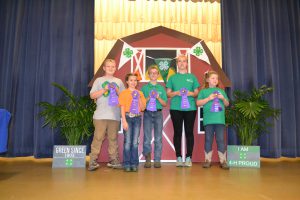
Best of Breed winners from the 2018 4-H Chick Chain.
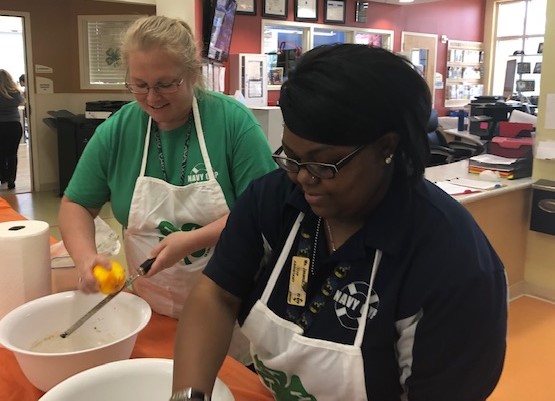
by pmdavis | Feb 14, 2019
Making lotions and bath scrubs, practicing relaxation and doing yoga…doesn’t this sound like a great 4-H club program? Discover 4-H Spa and Relaxation Clubs are a great way to learn about homemade body products while learning relaxation techniques. Youth create a day at the spa by making lotions, soaps, scrubs and lip balms while learning methods to relax like tennis ball massages, creating a happy list, doing yoga and creating a zen garden. An added bonus is homemade products are a fraction of the cost of purchasing and make great gifts for friends and family.
Make your own Luxurious Bath Salts
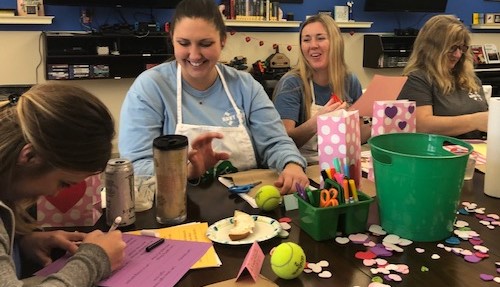
Naval Support Activity-Panama City staff learning how to making calm bags.
- ½ cup baking soda
- ½ cup powdered milk
- 1 cup sea salt
- 1 cup Epsom salt ( scented or plain)
- Use 3-5 drops fragrance oil designed for soaps or diluted essential oil for plain Epsom salt
- Mix ingredients
- Spoon the mixture into storage containers (wide mouth jars, bowls or zip style bags work well)
- Label your container with ingredients and direction for use – Pinterest has several cute label designs
Caution: Essential oils are very strong and can be a skin irritant if applied directly to your skin. National Association for Holistic Aromatherapy recommends diluting essential oils with a carrier oil: use 1 teaspoon of coconut, almond, olive, sunflower or jojoba oil with 2 – 12 drops of the desired essential oil. Then, mix 3-5 drops of the diluted oil to your bath salt mixture. Bath salts are generally safe for most when used properly, but you should talk to your doctor before using bath salts if you have medical conditions such as skin diseases, heart disease or diabetes.
How to Use Your Bath Salts: Fill your tub halfway with warm to hot water, and pour in about 1/2 cup (120 g) of bath salts. For a stronger concentration, you can always add more. If you prefer showers, take a handful and rub over desired area. Bath salts are great to exfoliate by removing dead skin cells leaving the skin smooth and fresh. Tired achy feet or hands? No problem! Add salts to warm water in a dishpan, and immerse your feet or hands and soak away the pain.

NSA-PC staff learning the 4-H Spa & Relaxation Curricula they will use in their 4-H programs.
For more information on 4-H and other programs like this, contact your local UF/IFAS County Extension Office, or visit Florida 4-H.
Are you an adult looking for ways to coach, teach and mentor youth? Contact the 4-H Agent in your county and enroll as a volunteer in 4-H Online. Volunteering not only strengthens the 4-H club, but also shows young people how to live with integrity, optimism, hope, determination, compassion, responsibility and resiliency – skills that will help them succeed in life.
Resource:
Discover 4-H Spa and Relaxation Clubs curriculum











